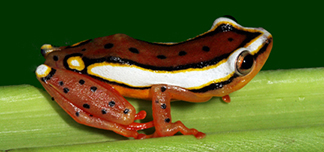| Publication Type: | Journal Article |
| Year of Publication: | 1993 |
| Authors: | L. S. Ford |
| Journal: | Ethology Ecology & Evolution |
| Volume: | 5 |
| Pagination: | 219-231 |
| Abstract: | Dart-poison frogs (family Dendrobatidae) are well known for the bright colors and toxic skin alkaloids of some members. These small inhabitants of tropical forests comprise 157 named species placed in six genera. Despite the growing interest in all aspects of dendrobatid biology, the placement of the family in relation to other anurans remains controversial because of differing views concerning the identity of its sister group. The dendrobatids are hypothesized to be derived from within either the Leptodactylidae or the Ranidae, which are classified in the superfamilies Bufonoidea and Ranoidea, respectively. These extremely divergent hypotheses of relationships were derived traditionally from limited numbers of characters. Examples of a few characters that support the leptodactylid hypothesis include aspects of cranial morphology and procoelous vertebrae, and those that support the ranid hypothesis include round sacral diapophyses and the presence of bursa angularis oris. Interestingly, some characters were used to support both hypotheses, owing to different interpretations of the same characters (e.g., pectoral girdle, thigh musculature). In reviewing the hypotheses and characters, it is evident that many complications concerning the placement of the Dendrobatidae reflect inherent problems with most of the characters, including homoplasy, ambiguous and erroneous reporting of characters, and a priori assumptions concerning character evolution. |
